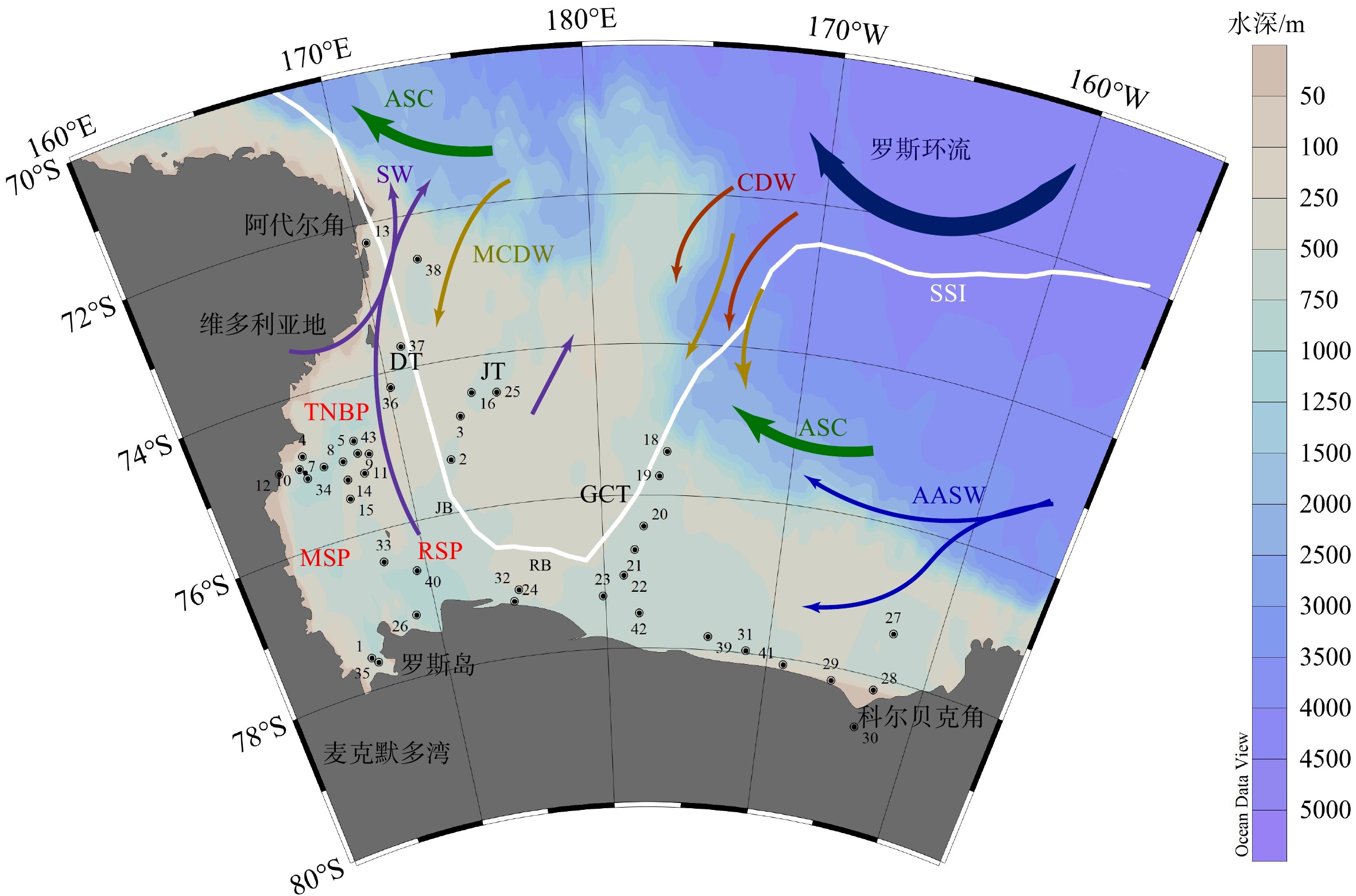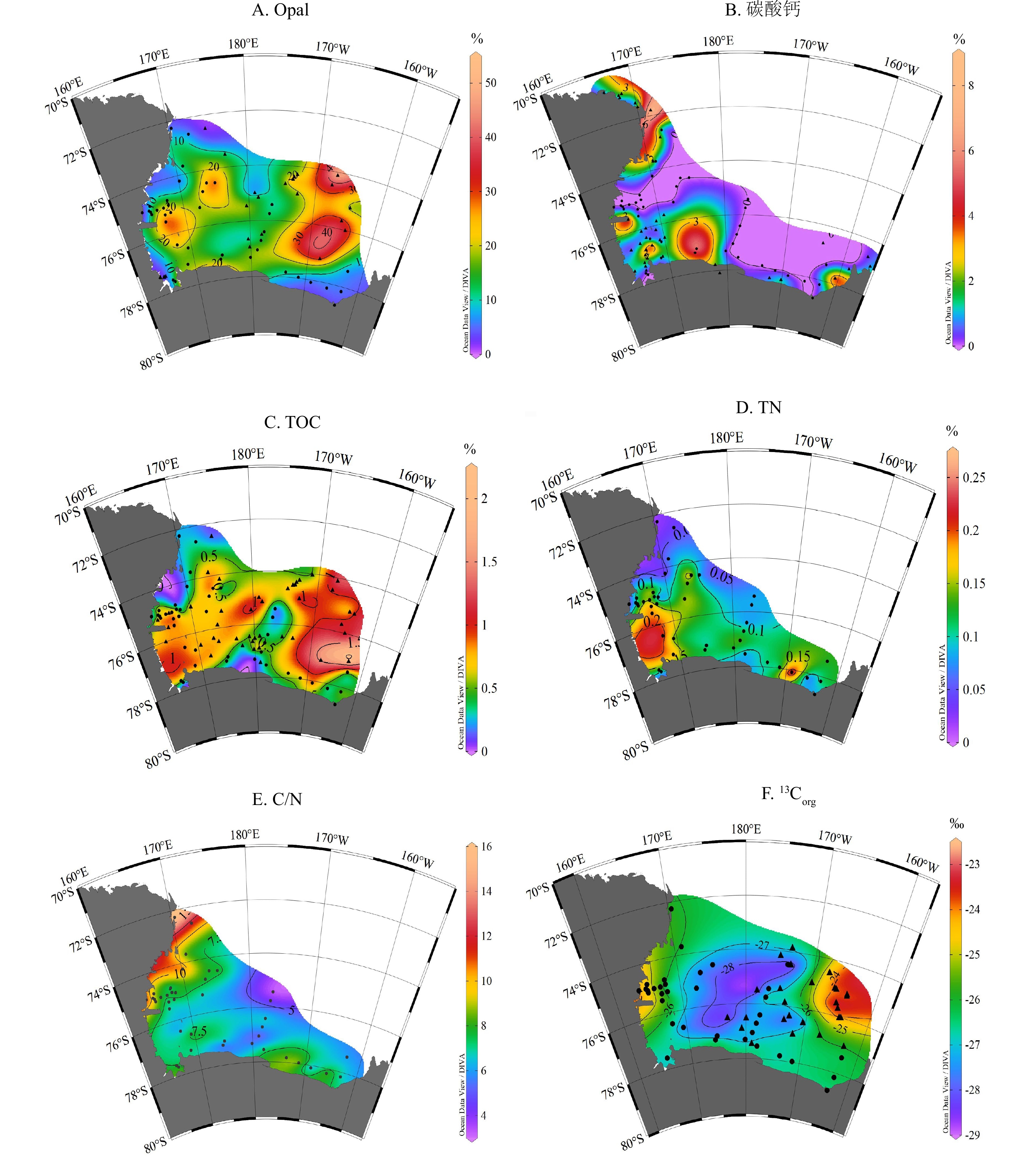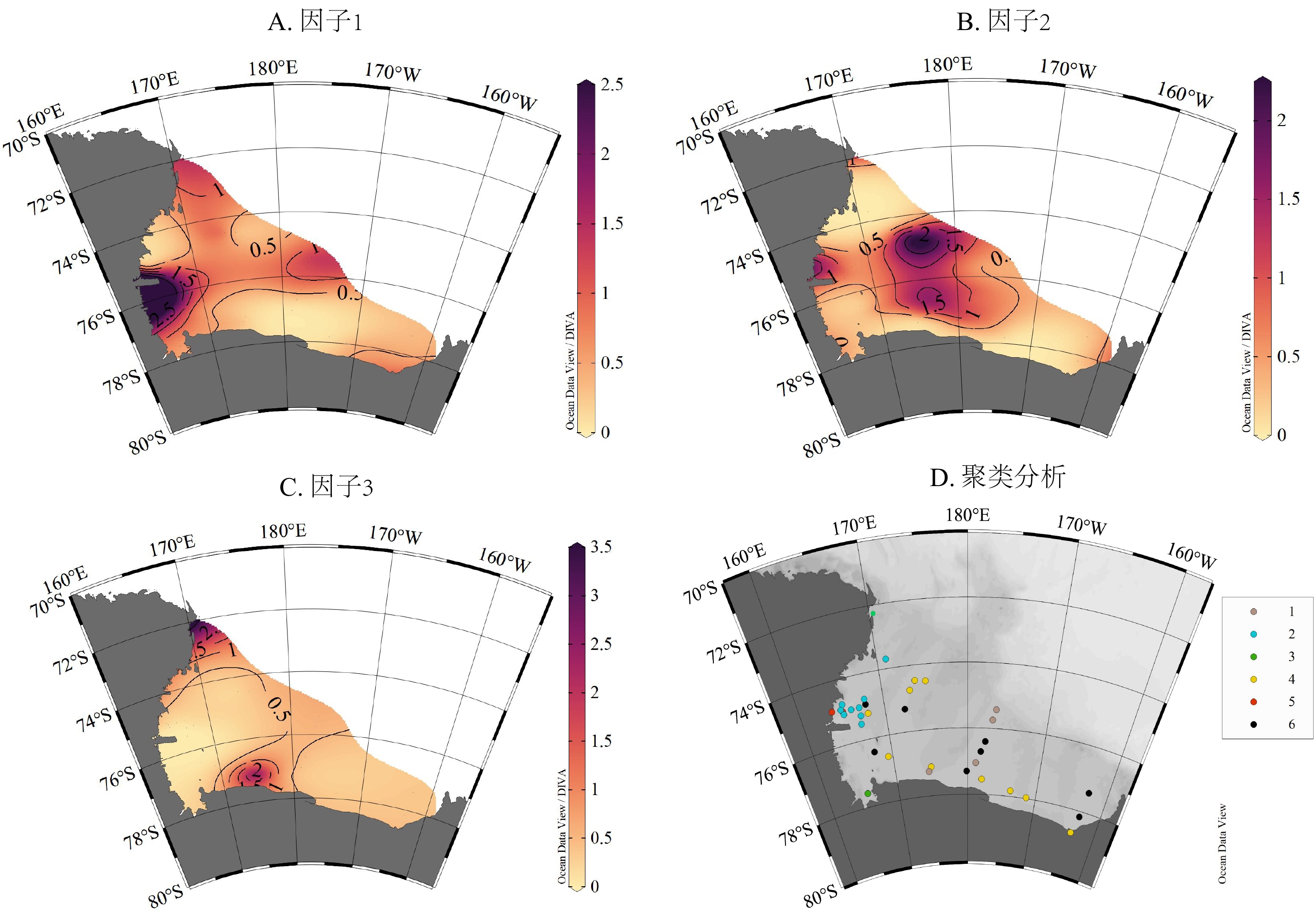Distribution patterns of biogenic components in surface sediments of the Ross Sea and their environmental implications
-
摘要:
罗斯海陆架是南极边缘海初级生产力最高的区域,是研究冰–海–气相互作用和碳循环的热点区域。 本文分析了中国第31–35次南极科考在罗斯海陆架区域采集的43个表层沉积物中的生源组分生物硅(Opal)、碳酸钙、总有机碳(TOC)、总氮(TN)含量和有机碳δ13C(δ13Corg)等指标,通过对这些指标聚类分析和因子分析,并与环境参数对比,研究了罗斯海生源要素的空间分布规律及其对环境的指示意义。结果显示,在罗斯海陆架区域内,TOC、TN、Opal是因子1的主要变量,代表水体生产力。其含量在西南陆架冰间湖和东南陆架地区显示高值,在阿代尔角外陆架地区显示低值,推测主要受溶解铁浓度的影响。δ13Corg是因子2的主要变量,其含量在特拉诺瓦湾冰间湖以及东北外陆架地区较高,在盆地海槽地区较低。δ13Corg的重值分布与生产力勃发有关,轻值分布与陆源有机碳的输入有关。碳酸钙是因子3的主要变量,含量在阿代尔角以及罗斯海冰间湖较高,在盆地海槽以及东部陆架地区较低,其含量主要受到保存效率的影响。
Abstract:The Ross Sea shelf is characterized by its highest primary productivity among the Antarctic marginal seas, and is a hotspot for studying ice-ocean-atmosphere interactions and carbon cycle. This study analyzed the contents of biogenic components such as biogenic silica (Opal), carbonate, total organic carbon (TOC), total nitrogen (TN), and organic carbon δ13C (δ13Corg) in 43 surface sediments collected during the 31st-35th Chinese Antarctic Research Expeditions on the Ross Sea shelf. Cluster analysis and factor analysis were performed on the resulted data in order to obtain their distribution patterns in relation to the environmental settings. Our results show that TOC, TN and Opal are the main variables for factor 1 representing the productivity of the water column. Their contents show high values in the polynyas on the southwest shelf, and on the southeast inner shelf, in contrast to low values in the Cape Adare and outer shelf, interpreted as related to concentrations of dissolved iron in the water. δ13Corg is the main variable for factor 2, with higher values in the Terra Nova Bay polynyas and the outer northeast shelf, and lower values in the troughs. The heavier δ13Corg is resulted from high primary productivity while the lighter δ13Corg mainly reflects terrestrial carbon accumulation from lateral transport. Carbonate is the main variable for factor 3 showing higher contents at Cape Adare and in the Ross Sea polynyas, and lower contents in the troughs and the south-eastern shelf, primarily related to its preservation.
-
Key words:
- Ross Sea /
- surface sediments /
- biogenic parameters /
- seawater surface productivity
-

-
图 1 南极罗斯海陆架区概况[2]与2002—2011年南半球夏季海冰分布范围(https://earthdata.nasa.gov)
Figure 1.
表 1 ANT31-35航次表层样信息
Table 1. Information of the studied surface sediment samples retrieved from ANT 31-35 expeditions
航次 站位号 位置 水深/m 取样方式 序号 ANT31 JB01 77°35′18″S, 165°34′10″E 774 箱式样 1 JB04(0~10 cm) 75°18′04″S, 172°22′21″E 510.8 箱式样 2 JB05(0~5 cm) 74°45′19″S, 173°11′17″E 496.8 箱式样 3 R02 74°47′6″S, 165°7′59″E 719.2 箱式样 4 R05(0~5 cm) 74°46′36″S, 167°46′39″E 585.6 箱式样 5 R08 75°00′11″S, 165°00′43″E 891.8 箱式样 6 R09 75°00′12″S, 165°59′53″E 1032.1 箱式样 7 R10 74°59′68″S, 167°00′07″E 636 箱式样 8 R11(0~5 cm) 74°56′57″S, 167°48′20″E 449.4 箱式样 9 R14 74°56′06″S, 164°48′17″E 901.1 箱式样 10 R17 75°13′49″S,167°54′33″E 374.4 箱式样 11 R18 74°54′46.8″S, 163°45′50′E 46 箱式样 12 R19 72°15′16″S, 170°23′40″E 516.3 箱式样 13 R16 75°15′15″S, 166°59′50″E 486.74 多管样 14 R20 75°30′16″S, 166°50′52″E 425.59 多管样 15 JB06 74°28′22″S, 173°54′24″E 567.52 重力样 16 AB18B 71°53′55″S, 128°8′42″W 3463 箱式样 17 ANT32 RB02B 75°25′24″S, 176°29′9″W 574 箱式样 18 RB03B 75°44′48″S, 176°52′11″W 610 箱式样 19 RB05B 76°24′19″S, 177°43′10″W 606 箱式样 20 RB06B 76°42′48″S, 178°14′25″W 619 箱式样 21 RB07B 77°02′59″S, 178°54′01″W 628.3 箱式样 22 RB08B 77°18′32″S, 179°51′09″E 669.7 箱式样 23 RB11B 77°16′10″S, 174°35′59″E 494.9 箱式样 24 RB16B 74°30′49″S, 175°07′18″E 478 箱式样 25 RB15C 77°12′7″S, 168°47′19″E 939.8 重力样 26 A1-05 77°23′46″S, 162°40′41″W 658.3 箱式样 27 ANT33 A1-07 78°10′5″S, 163°2′20″W 678.8 箱式样 28 A1-08 78°10′19″S, 165°47′17″W 497.6 箱式样 29 RS78 78°41′38″S, 163°40′1″W 331.06 箱式样 30 A1-10 77°58′5″S, 171°22′23″W 514.9 箱式样 31 A1-15 77°7′37″S, 174°57′50″E 399.9 箱式样 32 A1-18 76°25′16″S, 167°43′26″E 742.8 箱式样 33 I5 75°5′13″S, 165°2′53″E 1174 箱式样 34 A1-20 77°39′58″S, 165°53′6″E 590.1 箱式样 35 A2-02 74°12′22″S, 170°7′5″E 654 箱式样 36 A2-03 73°42′4″S, 170°58′44″E 588 箱式样 37 A2-05 72°36′18″S, 172°26′13″E 546.2 箱式样 38 A1-11 77°49′34″S, 173°47′17″W 530.4 多管样 39 A1-17 76°38′10″S, 169°23′46″E 804.5 多管样 40 A1-09 78°5′2″S, 168°57′7″W 586 重力样 41 A1-13 77°32′42″S, 178°1′16″W 663.8 重力样 42 ANT35 R1-03 74°59′43″, 168°21′28″E 348.6 箱式样 43 注:除标注外,其他站位的样品为0~2 cm表层沉积物;序号位置见图1。 -
[1] Smith W O Jr, Ainley D G, Arrigo K R, et al. The oceanography and ecology of the Ross Sea [J]. Annual Review Marine Science, 2014, 6: 469-487. doi: 10.1146/annurev-marine-010213-135114
[2] Morrison A K, Frölicher T L, Sarmiento J L. Upwelling in the Southern Ocean [J]. Physics Today, 2015, 68(1): 27-32. doi: 10.1063/PT.3.2654
[3] Tremblay J E, Smith W O Jr. Primary production and nutrient dynamics in polynyas [J]. Elsevier Oceanography Series, 2007, 74: 239-269.
[4] Parish T R, Cassano J J, Seefeldt M W. Characteristics of the ross ice shelf air stream as depicted in Antarctic mesoscale prediction system simulations [J]. Journal of Geophysical Research:Atmospheres, 2006, 111(D12): D12109. doi: 10.1029/2005JD006185
[5] Catalano G, Budillon G, La Ferla R, et al. The ross sea[M]//Liu K K, Atkinson L, Quinones R, et al. Carbon and nutrient Fluxes in Continental Margins: A Global Synthesis. New York: Springer-Verlag, 2010, 6: 303-318.
[6] Thornton S F, McManus J. Application of organic carbon and nitrogen stable isotope and C/N ratios as source indicators of organic matter provenance in estuarine systems: evidence from the Tay Estuary, Scotland [J]. Estuarine, Coastal and Shelf Science, 1994, 38(3): 219-233. doi: 10.1006/ecss.1994.1015
[7] Emerson S, Hedges J I. Processes controlling the organic carbon content of open ocean sediments [J]. Paleoceanography, 1988, 3(5): 621-634. doi: 10.1029/PA003i005p00621
[8] Stein R. Accumulation of organic carbon in marine sediments[M]. Berlin: Springer-Verlag, 1991: 217-320.
[9] Hauck J, Gerdes D, Hillenbrand C D, et al. Distribution and mineralogy of carbonate sediments on Antarctic shelves [J]. Journal of Marine Systems, 2012, 90(1): 77-87. doi: 10.1016/j.jmarsys.2011.09.005
[10] Rack W, Price D, Haas C, et al. Sea ice thickness in the western Ross Sea [J]. Geophysical Research Letters, 2021, 48(1): e2020GL090866. doi: 10.1029/2020GL090866
[11] Arrigo K R, Worthen D L, Robinson D H. A coupled ocean-ecosystem model of the Ross Sea: 2. Iron regulation of phytoplankton taxonomic variability and primary production [J]. Journal of Geophysical Research:Oceans, 2003, 108(C7): 3231. doi: 10.1029/2001JC000856
[12] Nelson D M, DeMaster D J, Dunbar R B, et al. Cycling of organic carbon and biogenic silica in the Southern Ocean: Estimates of water-column and sedimentary fluxes on the Ross Sea continental shelf [J]. Journal of Geophysical Research:Oceans, 1996, 101(C8): 18519-18532. doi: 10.1029/96JC01573
[13] Sweeney C, Hansell D A, Carlson C A, et al. Biogeochemical regimes, net community production and carbon export in the Ross Sea, Antarctica [J]. Deep Sea Research Part II:Topical Studies in Oceanography, 2000, 47(15-16): 3369-3394.
[14] Marsay C M, Barrett P M, McGillicuddy D J, et al. Distributions, sources, and transformations of dissolved and particulate iron on the Ross Sea continental shelf during summer [J]. Journal of Geophysical Research:Oceans, 2017, 122(8): 6371-6393. doi: 10.1002/2017JC013068
[15] Anderson J B, Conway H, Bart P J, et al. Ross Sea paleo-ice sheet drainage and deglacial history during and since the LGM [J]. Quaternary Science Reviews, 2014, 100: 31-54. doi: 10.1016/j.quascirev.2013.08.020
[16] Orsi A H, Wiederwohl C L. A recount of Ross Sea waters [J]. Deep Sea Research Part II:Topical Studies in Oceanography, 2009, 56(13-14): 778-795. doi: 10.1016/j.dsr2.2008.10.033
[17] Peloquin J A, Smith W O Jr. Phytoplankton blooms in the Ross Sea, Antarctica: Interannual variability in magnitude, temporal patterns, and composition [J]. Journal Geophysical Research:Oceans, 2007, 112(C8): C08013.
[18] Sedwick P N, DiTullio G R, Mackey D J. Iron and manganese in the Ross Sea, Antarctica: Seasonal iron limitation in Antarctic shelf waters [J]. Journal of Geophysical Research:Oceans, 2000, 105(C5): 11321-11336. doi: 10.1029/2000JC000256
[19] Arrigo K R, Van Dijken G L. Annual changes in sea-ice, chlorophyll a, and primary production in the Ross Sea, Antarctica [J]. Deep Sea Research Part II:Topical Studies in Oceanography, 2004, 51(1-3): 117-138. doi: 10.1016/j.dsr2.2003.04.003
[20] Smith W O, Nelson D M. Phytoplankton bloom produced by a receding ice edge in the Ross Sea: spatial coherence with the density field [J]. Science, 1985, 227(4683): 163-166. doi: 10.1126/science.227.4683.163
[21] Garcia H, Locarnini R A, Boyer T P, et al. Nutrients (phosphate, nitrate, silicate)[Z]. World Ocean Atlas 2005, 2010, 4.
[22] Burckle L H. Distribution of opal in surface sediments, compiled from different sources[Z]. PANGAEA, 2001.
[23] Andrews J T, Domack E W, Cunningham W L, et al. Problems and possible solutions concerning radiocarbon dating of surface marine sediments, Ross Sea, Antarctica [J]. Quaternary Research, 1999, 52(2): 206-216. doi: 10.1006/qres.1999.2047
[24] Ohkouchi N, Eglinton T I. Radiocarbon constraint on relict organic carbon contributions to Ross Sea sediments [J]. Geochemistry, Geophysics, Geosystems, 2006, 7(4): Q04012.
[25] Villinski J C, Dunbar R B, Mucciarone D A. Carbon 13/Carbon 12 ratios of sedimentary organic matter from the Ross Sea, Antarctica: A record of phytoplankton bloom dynamics [J]. Journal of Geophysical Research:Oceans, 2000, 105(C6): 14163-14172. doi: 10.1029/1999JC000309
[26] Mortlock R A, Froelich P N. A simple method for the rapid determination of biogenic opal in pelagic marine sediments [J]. Deep Sea Research Part A. Oceanographic Research Papers, 1989, 36(9): 1415-1426. doi: 10.1016/0198-0149(89)90092-7
[27] Arthur D, Vassilvitskii S. K-Means++: the advantages of careful seeding[C]//Proceedings of the Eighteenth Annual ACM-SIAM Symposium on Discrete Algorithms, SODA 2007. New Orleans, Louisiana, USA: ACM, 2007: 1027-1035.
[28] Reddon J R, Jackson D N. A note on testing the sphericity hypothesis with Bartlett’s test [J]. Multivariate Experimental Clinical Research, 1984, 7(1): 49-52.
[29] Kaiser H F, Rice J. Little Jiffy, Mark Iv [J]. Educational and Psychological Measurement, 1974, 34(1): 111-117. doi: 10.1177/001316447403400115
[30] 滕聿央, 王汝建. 南极罗斯海表层沉积物中的放射虫组合分布及与其他硅质生物关系和环境生态意义[J]. 微体古生物学报, 2019, 36(4):377-398
TENG Yuyang, WANG Rujian. Biogenic silica and radiolarian assemblages in the surface sediments of Ross Sea, Antarctica and their implications on marine environment and ecology [J]. Acta Micropalaeontologica Sinica, 2019, 36(4): 377-398.
[31] 黄梦雪, 王汝建, 肖文申, 等. 罗斯海西北陆架(JOIDES海槽)末次冰期以来冰架消融过程及水动力变化[J]. 海洋地质与第四纪地质, 2016, 36(5):97-108
HUANG Mengxue, WANG Rujian, XIAO Wenshen, et al. Retreat process of ross ice shelf and hydrodynamic changes on northwestern ross continental shelf since the last glacial [J]. Marine Geology & Quaternary Geology, 2016, 36(5): 97-108.
[32] Langone L, Frignani M, Labbrozzi L, et al. Present-day biosiliceous sedimentation in the northwestern Ross Sea, Antarctica [J]. Journal of Marine Systems, 1998, 17(1-4): 459-470. doi: 10.1016/S0924-7963(98)00058-X
[33] Bentley M J, Cofaigh C Ó, Anderson J B, et al. A community-based geological reconstruction of Antarctic Ice Sheet deglaciation since the Last Glacial Maximum [J]. Quaternary Science Reviews, 2014, 100: 1-9. doi: 10.1016/j.quascirev.2014.06.025
[34] Leventer A, Dunbar R B. Factors influencing the distribution of diatoms and other algae in the Ross Sea [J]. Journal of Geophysical Research:Oceans, 1996, 101(C8): 18489-18500. doi: 10.1029/96JC00204
[35] DeMaster D J, Ragueneau O, Nittrouer C A. Preservation efficiencies and accumulation rates for biogenic silica and organic C, N, and P in high-latitude sediments: The Ross Sea [J]. Journal of Geophysical Research:Oceans, 1996, 101(C8): 18501-18518. doi: 10.1029/96JC01634
[36] Winton V H L, Dunbar G B, Bertler N A N, et al. The contribution of aeolian sand and dust to iron fertilization of phytoplankton blooms in southwestern Ross Sea, Antarctica [J]. Global Biogeochemical Cycles, 2014, 28(4): 423-436. doi: 10.1002/2013GB004574
[37] Winton V H L, Dunbar G B, Atkins C B, et al. The origin of lithogenic sediment in the south-western Ross Sea and implications for iron fertilization [J]. Antarctic Science, 2016, 28(4): 250-260. doi: 10.1017/S095410201600002X
[38] DeJong H B, Dunbar R B. Air-sea CO2 exchange in the Ross Sea, Antarctica [J]. Journal of Geophysical Research:Oceans, 2017, 122(10): 8167-8181. doi: 10.1002/2017JC012853
[39] Tesi T, Belt S T, Gariboldi K, et al. Resolving sea ice dynamics in the north-western Ross Sea during the last 2.6 ka: From seasonal to millennial timescales [J]. Quaternary Science Reviews, 2020, 237: 106299. doi: 10.1016/j.quascirev.2020.106299
[40] Rivaro P, Ardini F, Vivado D, et al. Potential sources of particulate iron in surface and deep waters of the terra Nova Bay (Ross Sea, Antarctica) [J]. Water, 2020, 12(12): 3517. doi: 10.3390/w12123517
[41] Mack S L, Dinniman M S, McGillicuddy D J Jr, et al. Dissolved iron transport pathways in the Ross Sea: Influence of tides and horizontal resolution in a regional ocean model [J]. Journal of Marine Systems, 2017, 166: 73-86. doi: 10.1016/j.jmarsys.2016.10.008
[42] Salmon E, Hofmann E E, Dinniman M S, et al. Evaluation of iron sources in the Ross Sea [J]. Journal of Marine Systems, 2020, 212: 103429. doi: 10.1016/j.jmarsys.2020.103429
[43] De Baar H J W, Boyd P W, Coale K H, et al. Synthesis of iron fertilization experiments: from the iron age in the age of enlightenment [J]. Journal of Geophysical Research:Oceans, 2005, 110(9): C09S16.
[44] Tsuda A, Takeda S, Saito H, et al. A mesoscale iron enrichment in the western subarctic pacific induces a large centric diatom bloom [J]. Science, 2003, 300(5621): 958-961. doi: 10.1126/science.1082000
[45] 任春燕, 陈敏, 高众勇, 等. 南极普里兹湾及其邻近海域悬浮颗粒有机物的碳同位素组成及其影响因素[J]. 海洋学报, 2015, 37(12):74-84
REN Chunyan, CHEN Min, GAO Zhongyong, et al. Stable carbon isotopic composition of suspended particulate organic matter in the Prydz Bay and its adjacent areas [J]. Acta Oceanologica Sinica, 2015, 37(12): 74-84.
[46] Lamb A L, Wilson G P, Leng M J. A review of coastal palaeoclimate and relative sea-level reconstructions using δ13C and C/N ratios in organic material [J]. Earth-Science Reviews, 2006, 75(1-4): 29-57. doi: 10.1016/j.earscirev.2005.10.003
[47] Rivaro P, Ianni C, Raimondi L, et al. Analysis of physical and biogeochemical control mechanisms on summertime surface carbonate system variability in the western Ross Sea (Antarctica) using in situ and satellite data [J]. Remote Sensing, 2019, 11(3): 238. doi: 10.3390/rs11030238
[48] Smith W O Jr, Comiso J C. Influence of sea ice on primary production in the Southern Ocean: A satellite perspective [J]. Journal of Geophysical Research, 2008, 113(C5): C05S93.
[49] Hunt B P V, Pakhomov E A, Hosie G W, et al. Pteropods in Southern ocean ecosystems [J]. Progress in Oceanography, 2008, 78(3): 193-221. doi: 10.1016/j.pocean.2008.06.001
[50] 韩喜彬, 赵军, 初凤友, 等. 南极半岛东北海域表层沉积有机质来源及其沉积环境[J]. 海洋学报, 2015, 37(8):26-38
HAN Xibin, ZHAO Jun, CHU Fengyou, et al. The source of organic matter and its sedimentary environment of the bottom surface sediment in northeast waters to Antarctic Peninsula based on the biomarker features [J]. Acta Oceanologica Sinica, 2015, 37(8): 26-38.
[51] Rivaro P, Messa R, Ianni C, et al. Distribution of total alkalinity and pH in the Ross Sea (Antarctica) waters during austral summer 2008 [J]. Polar Research, 2014, 33(1): 20403. doi: 10.3402/polar.v33.20403
[52] Bergamasco A, Defendi V, Budillon G, et al. Downslope flow observations near Cape Adare shelf-break [J]. Antarctic Science, 2004, 16(2): 199-204. doi: 10.1017/S0954102004001981
[53] Melis R, Salvi G. Foraminifer and ostracod occurrence in a cool-water carbonate factory of the cape Adare (Ross Sea, Antarctica): a key lecture for the climatic and oceanographic variations in the Last 30, 000 years [J]. Geosciences, 2020, 10(10): 413. doi: 10.3390/geosciences10100413
[54] Kim S, Lee J I, McKay R M, et al. Late Pleistocene paleoceanographic changes in the Ross Sea-Glacial-interglacial variations in paleoproductivity, nutrient utilization, and deep-water formation [J]. Quaternary Science Reviews, 2020, 239: 106356. doi: 10.1016/j.quascirev.2020.106356
-




 下载:
下载:


